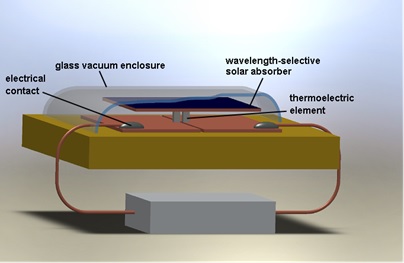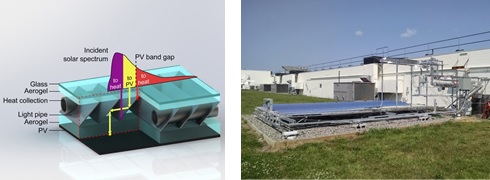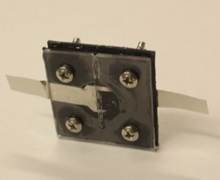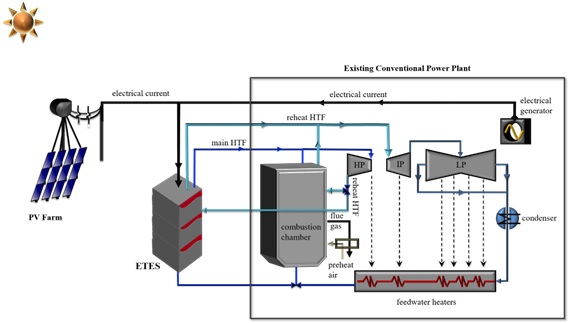Clean Energy
Over 90% of the energy input to our society is heat, and yet we only use ~45% of that energy input, wasting the rest. The sun itself is a heat source at ~5800 K. The second law of thermodynamics tells us we have ample room to invent and to improve the energy conversion and utilization technologies. We specialize in harvesting thermal energy, including solar. We are developing innovative energy technologies to improve the efficiency of solar energy utilization and recovery of waste heat into useful work, and to facilitate the transition from fossil to renewable energy future.
Thermoelectric Energy Conversion Using Sunlight and Body Heat
Thermoelectric energy conversion works through the Seebeck effect: when a temperature difference is applied to a material, a voltage is generated. (This is how a thermocouple measures temperature!) The same effect can be used to convert heat into electricity. Our work in this area spans from first principles simulations based on quantum mechanics (density functional theory) to materials advances and device innovations. We have significantly improved the performance of thermoelectric materials via nanostructuring. Using these materials, we demonstrated innovative solar thermoelectric energy conversion devices with record high efficiency. This energy conversion technology was called the “third way” of converting sunlight into electricity by The Economist magazine. We also have worked on using thermoelectrics for recovering waste heat from vehicles and combining them with home hot water systems for co-generation of electricity and heat. We are also working on developing body heat-based thermoelectric generators to power sensors for Internet of things (IoT) applications.
 Soler Thermoelectric Generator
Soler Thermoelectric Generator
Key Publications
- Daniel Kraemer, Bed Poudel, Hsien-Ping Feng, J. Christopher Caylor, Bo Yu, Xiao Yan, Yi Ma, Xiaowei Wang, Dezhi Wang, Andrew Muto, Kenneth McEnaney, Qing Hao, Matteo Chiesa, Zhifeng Ren, and Gang Chen, “High-performance flat-panel solar thermoelectric generators with large thermal concentration,” Nature Materials, 10, 532-538, 2011.
- Daniel Kraemer, Qing Jie, Kenneth McEnaney, Feng Cao, Weishu Sui, Lee Weinstein, James Loomis, Zhifeng Ren, and Gang Chen, “Concentrating solar thermoelectric generators with a peak efficiency of 7.4%,” Nature Energy, 1, 16153, 2016.
Photovoltaics Using Sunlight and Thermal Radiation
Silicon-based solar photovoltaics (PV) dominate the current solar energy market. To drive down the cost of solar PV, we worked on further reducing the amount of silicon used in PV cells. One challenge in reducing the materials is that silicon does not absorb sunlight well near its bandgap. We started from simulations of different ways to nanostructure silicon to trap sunlight, then moved on to fabricate thin-film crystalline-silicon based solar cells. We developed combined photon and electron transport models to guide device design. We demonstrated experimentally >15% efficiency PV cells using a 10 micron thick single-crystal silicon film and expect that even higher efficiencies can be achieved.
In addition to solar energy harvesting, PV can also be coupled to a terrestrial heat source to generate electricity through thermophotovoltaics (TPV). Because heat sources on earth are typically at a much lower temperature than the sun, the key to high efficiency TPVs is to reduce the number of photons lost below the PV cell bandgap. We have worked on different approaches to improve TPV efficiency, from selective emitters to photon recycling via back reflectors.
 Nanostructured c-Si Thin-Film Solar Cells
(Left: SEM Image of Texture; Middle: Textured Cell; Right: Nontextured)
Nanostructured c-Si Thin-Film Solar Cells
(Left: SEM Image of Texture; Middle: Textured Cell; Right: Nontextured)
Key Publications
- Ognjen Ilic, Peter Bermel, Gang Chen, John D. Joannopoulos, Ivan Celanovic, Marin Soljačić, “Tailoring ultra-high temperature radiation: the resurrection of the incandescent source,” Nature Nanotechnology, 11, 320-324, 2016.
- Matthew S. Branham, Wei-Chun Hsu, Selcuk Yerci, and Gang Chen, “15.7% Efficient, 10-μm-Thick Crystalline Silicon Solar Cells Enabled by Periodic Surface Light Trapping Structures,” Advanced Materials, 27, 2182, 2015.
- Jonathan K. Tong, Wei-Chun Hsu, Yi Huang, Svetlana V. Boriskina, and Gang Chen, "Thin-film Thermal Emitters for High-Efficiency Thermophotovoltaics,” Scientific Reports, 5, 10661, 2015.
Solar Thermal and Power
Sunlight can be used to generate electricity via photovoltaics or steam turbines. The latter, called concentrated solar power (CSP), relies on optical components to concentrate sunlight to high intensities to reach higher temperatures. The price of electricity generation using PV cells has dropped faster than the CSP-based approach. However, PV electricity fluctuates with sunlight availability. CSP has the potential to store sunlight as heat for future use. We have developed an innovative system to combine solar PV and CSP. This is based on developing sunlight-transparent but infrared radiation-trapping aerogels (in collaboration with Prof. Evelyn Wang’s group). Such transparent aerogels also enable new CSP systems and have achieved record high steam temperatures even without any optical components to concentrate sunlight. We have also developed solar selective surfaces: surfaces that maximize sunlight absorption into heat but minimize heat loss via thermal radiation (in collaboration with Professor Zhifeng Ren at University of Houston). We have also achieved superheated steam using cheap materials (see Clean Water).
 Left: Conceptual Design of a Combined PV and CSP Collector. Right: Fresnel Solar Collector Testing Setup
Left: Conceptual Design of a Combined PV and CSP Collector. Right: Fresnel Solar Collector Testing Setup
Key Publications
- Lin Zhao, Bikram Bhatia, Sungwoo Yang, Elise Strobach, Lee A. Weinstein, Thomas A. Cooper, Gang Chen and Evelyn N. Wang, “Harnessing Unconcentrated Sunlight beyond 250 °C with a Greenhouse Cavity,” ACS Nano, 13, 7503-7516, 2019.
- Lee A. Weinstein, Ken McEnaney, Elise Strobach, Sungwoo Yang, Bikram Bhatia, Lin Zhao, Yi Huang, James Loomis, Feng Cao, Svetlana V. Boriskina, Zhifeng Ren, Evelyn N. Wang, and Gang Chen, “A Hybrid Electric and Thermal Solar Receiver” Joule, 2, 962-975, 2018.
- Feng Cao, Yi Huang, Lu Tang, Tianyi Sun, Svetlana V. Boriskina, Gang Chen, and Zhifeng Ren, “Wide-Angle Solar Spectral Splitter with Low Infrared Emittance for Hybrid Solar-Thermal Photovoltaic Applications,” Advanced Materials, 10.1002/adma.201603113, Vol. 28, 10659–10663, 2016.
- Lee Weinstein, James Loomis, Bikram Bhatia, David Bierman, Evelyn Wang, and Gang Chen, “Concentrating Solar Power”, Chemical Reviews, 115, 12797–12838, 2015.
Thermally Charged Batteries and Electrochemical Systems
Batteries are used in daily life and will play an increasingly important role for future energy systems. We charge batteries using electricity, of course! But battery voltage changes with temperature too, and this effect can be exploited for energy conversion. In collaboration with Professor Yi Cui’s group at Stanford, we invented a device to charge a battery using heat, making the battery into a thermal-to-electrical energy converter. This device was chosen by Scientific American as its one of top 10 World Changing Ideas in 2014. We are currently working on further advancing the technology, aiming to use such electrochemical systems to recover low grade waste heat and to refrigerate without using refrigerants that have high global warming potential. We throw away ~60% of energy input into our society in the form of waste heat, much of it at low temperatures. There are plenty opportunities in this domain.
 Thermally Charged Battery
Thermally Charged Battery
Key Publications
- Seok Woo Lee, Yuan Yang, Hyun-Wook Lee, Hadi Ghasemi, Daniel Kraemer, Gang Chen, Yi Cui, “An electrochemical system for highly efficient harvesting of low-grade heat energy,” Nature Communications, 5, 3942, 2014.
- Yuan Yang, James Loomis, Hadi Ghasemi, Seok Woo Lee, Jenny Wang, Yi Cui and Gang Chen, “A Membrane-free Battery for Harvesting Low-grade Thermal Energy,” Nano Letters, 14, 5678-6583, 2014.
- Yuan Yang, Seok Woo Lee, Hadi Ghasemi, Xiaobo Li, Daniel Kraemer, Jenny Wang, Yi Cui, and Gang Chen, “A Charging-free Electrochemical System for Harvesting Low-grade Heat Energy,” PNAS, 111, 17011-17016, 2014.
Thermal Energy Storage
The storage of electricity becomes one of the major challenges with increasing penetration of renewable energy. PV works only when the sun is out, and wind turbines turn only when there is wind, yet our lights need to be on at night. While batteries will certainly play a critical role in energy storage, we believe that thermal energy storage has great potential due to its intrinsic low cost. We have, for example, conceived a way to electrically heat a high-temperature phase-change system to store electricity when its cost is low and release the stored heat to generate steam to drive a steam turbine. The combined round trip efficiency is slightly higher than current power plants. Although this approach has lower efficiency than pumped hydro and batteries, these systems can be built in every existing power plant, leveraging the existing infrastructure in the power plant and grids to achieve extremely low costs. This could be a potential route for our transition to a 100% renewable system. We are also exploring other electricity-heat storage systems for a 100% renewable energy-based society for which heating is essential. Remember, we need hot water for showers and heat to keep our house warm in the winter.
 Concept of Electrically-Heated Thermal-Energy Storage (ETES) Integrated into Thermal Power Plant For Grid-Level Energy Storage
Concept of Electrically-Heated Thermal-Energy Storage (ETES) Integrated into Thermal Power Plant For Grid-Level Energy Storage
Key Publications
- Laureen Meroueh and Gang Chen, “Thermal Energy Storage Radiatively Coupledto Supercritical Rankine Cycle for Electric Grid Support,” Renewable Energy, 145, 604-621, 2020.